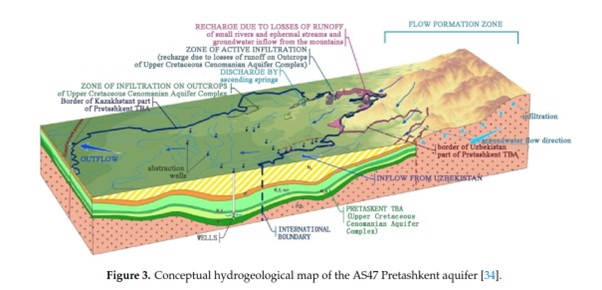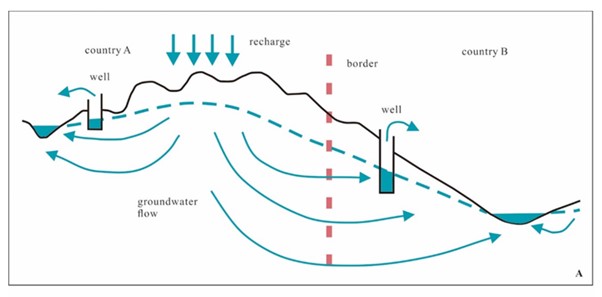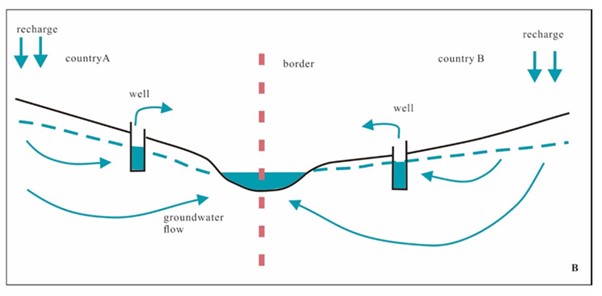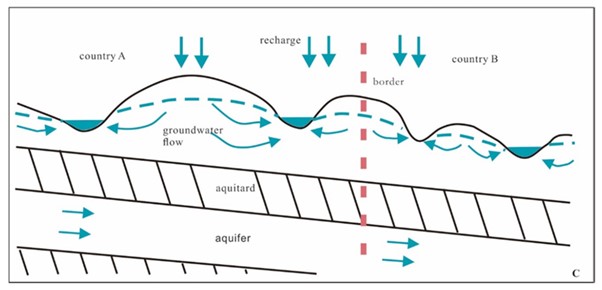nCa Report
Groundwater is an important – and generally rechargeable – source of water. In Central Asia, where the growing water shortage requires every possible effort to make responsible use of the water resources and ensure their sustainability.
The groundwater – literally the water in the ground – is usually not under the spotlight when we talk of the water resources.
In this report, we will quote from a research study on transboundary groundwater resources in Central Asia. Next, we will give some information from the Groundwater Resources Governance in Transboundary Aquifers (GGRETA) Project of UNESCO Intergovernmental Hydrological Programme. Finally, we will look at a highly laudable success story from India where a man with hardly any resources and education managed to devise a low cost solution for recharging the groundwater resources.
* * *
‘Sustainable Use of Groundwater Resources in the Transboundary Aquifers of the Five Central Asian Countries: Challenges and Perspectives’ is a useful research paper authored by Yu Liu, Ping Wang, Hongwei Ruan, Tianye Wang, Jingjie Yu, Yanpei Cheng and Rashid Kulmatov.
All the authors except Rashid Klmatov are affiliated with the scientific and research institutions of China. Rashid Klmatov is the head of biology and soil science at the National University of Uzbekistan.
The study was published by the Swiss-based open-source publisher MDPI in June 2020.
The abbreviation TBA is frequently used in the study. It means Transboundary Aquifers.
The complete study can be found at this link:
Before looking at the contents of the study, we should note that it deals with only transboundary groundwater resources, not all the groundwater resources in Central Asia.
The authors say in the abstract of the study: “Because transboundary aquifers do not follow borders and are concealed, neighboring countries are prone to experiencing conflicts over the use of these transboundary groundwater resources. Therefore, an accurate and comprehensive assessment of the development potential of groundwater resources in these transboundary aquifers is necessary for the rational and fair use of those groundwater resources. Transboundary groundwater resources are an important water source for life, production, and ecological water use in Central Asia, which has a distinctive continental arid and semi-arid climate, and surface water resources in this region are relatively scarce. Considering the existing problems related to the utilization of groundwater resources in the transboundary aquifers in this region, we propose developing strategies for on-demand water abstraction, enhancing the ecological protection of transboundary aquifers, and strengthening international cooperation. This paper summarizes the distribution of 34 transboundary aquifers in Central Asia and analyzes the status and potential of groundwater resource uses in these transboundary aquifers.”
Instead of quoting extensively from the study, we will reproduce here just some graphics and tables.
As shown on the TBA (Transboundary Aquifer) map, there are thirty-four major TBAs in Central Asia, 30 of which are partially located in Uzbekistan.
Numerous TBAs exist in the runoff formation zones in southeastern Kazakhstan, Kyrgyzstan, and Tajikistan. As shown in Figure2, 24 of the TBAs in the study area (AS36, AS45, AS46, AS47, AS48, AS49, AS50, AS51, AS52, AS53, AS56, AS57, AS58, AS59, AS60, AS61, AS62, AS63, AS64, AS65, AS66, AS67, AS68, and AS69) are located within the Syr Darya River basin, whereas six TBAs (AS37, AS40, AS41, AS42, AS43, and AS70) are located within the Amu Darya River basin, and only two aquifers (AS54 and AS55) are located in the Talas River basin. Additionally, the Zeravshan River basin and the Chu River basin each have only one aquifer, AS44 and AS71, respectively.
Groundwater Resources in TBAs
The groundwater resources in the five Central Asian countries are closely related to the amount of surface water resources. Kyrgyzstan and Tajikistan, as countries with relatively abundant surface water resources, use relatively few groundwater resources. In addition, Turkmenistan’s groundwater resources are relatively limited, but only 2.5% of its total water resources are exploited. The groundwater resources in these three countries are mainly used for domestic purposes. In contrast, Kazakhstan and Uzbekistan, which are located in the downstream reaches of river basins, have relatively scarce surface water resources and a relatively high dependence on groundwater. Irrigation accounts for approximately 50% of the groundwater extracted in Kazakhstan, and approximately two-thirds of Uzbekistan’s water demand depends on groundwater.
The groundwater resources associated with a given TBA may have different uses in different countries; for example, the AS47 Pretashkent aquifer is used mainly for drinking water in Kazakhstan, but is used only as a source of mineral water in Uzbekistan [37]. For the AS71 Chu aquifer in Kazakhstan, 40% of the extracted groundwater is used for drinking water and 60% is used for agricultural irrigation; however, in Kyrgyzstan, the groundwater from this aquifer is widely used for drinking water, agricultural irrigation, industrial mining, livestock feeding, and hot spring fishery needs [32].
These are just some illustrations from the valuable study prepared jointly by the Chinese and Uzbek scholars. For anyone interested in more details, it would be advisable to download and go through the entire research paper from the link given near start of this report. /// nCa, 23 April 2024









